This article by Jade Lewis appeared in the Cochrane Times.
We often tie the emergence of horses in the west to the colonial settlers, like Senator Matthew Cochrane, who imported the first Thoroughbred horse into western Canada. However, wild horses ran through this valley and were used by the indigenous people long before colonial settlers claimed Cochrane.
Contrary to popular belief, wild horses do not originate from the prehistoric North American horse, the last of which died out around 11,000 years ago. The wild horses we have today are actually escaped Spanish mustangs that were introduced to North America during the Spanish conquest. However, their previous domestication had little impact. The horses reverted to ancient behavioral patterns and evolved independently of the domestic horse.
Of course, during this time the genetic diversity of the wild horses was increased by other escaped domesticated horses. The horses in this area have intermingled with the good bloodstock of Thoroughbred, Arab and Quarter horses. This goes back to 1920 when a Ghost Forest Rancher raised 1,000 horses hoping to send them towards the war efforts. The war ended before he could send the horses, so instead, he set them loose.
The Stoney Nakoda nation has their own oral history of the wild horses on this land. The horse is a sacred animal for the Stoney people who say they were sent by the creator and accepted the responsibility of caring for the human race. It is believed that wild horses came from the water, from the lakes in the mountains. Their account describes the horses as having been first found around Kananaskis Lake.
For the Stoney people, the use of horses meant that many tasks such as hunting, trapping or traveling no longer had to be done on foot. The Stoney people traveled their territory from camp to camp and had originally used dog packs to carry supplies and the large tipi poles. Many elders recount the transition from this way of transport to the use of both the tamed wild horses and dogs to move camp.
“ The spirit of the horse is key to the survival of the first nations people; they rely on the spirit of every animal that the great spirit provided here on earth,” said Stoney knowledge holder Hank Snow. Today, the wild horses continue to roam the prairies, though their existence is threatened by decreasing habitat and looming culls. The Ghost Forest area in the most recent count has about 50 wild horses while the Central Foothills has 250. The voices of the Stoney elders echo a warning that the wild horses should be left alone in their environment, they should remain free so that they can be preserved for future generations. A living symbol of the importance of horses in this area long before homesteads.


